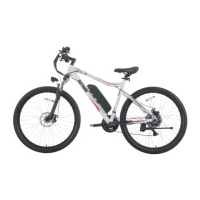Schraeder Valve Presta Valve
Tire pressure is given either as maximum pressure or as a pressure range. How a
tire performs under different terrain or weather conditions depends largely on tire
pressure. Inflating the tire to near its maximum recommended pressure gives the
lowest rolling resistance; but also produces the harshest ride. High pressures work
best on smooth, dry pavement. Very low pressure, at the bottom of the recom-
mmended pressure range, gives the best performance on smooth, slick terrain
such as hard-packed clay, and on deep, loose surfaces such as deep, dry sand. Tire
pressure that is too low for your weight and the riding conditions can cause a punc-
ture of the tube by allowing the tire to deform suffciently to pinch the inner tube
between the rim and the riding surface.
Some special high-performance tires have unidirectional treads: their tread
pattern is designed to work better in one direction than in the other. The sidewall
marking of a unidirectional tire will have an arrow showing the correct rotation
direction. If your bike has unidirectional tires, be sure that they are mounted to
rotate in the correct direction.
2. The tire valve allows air to enter the tire’s inner tube under pressure, but doesn’t
let it back out unless you want it to. There are primarily two kinds of bicycle tube
valves: The Schraeder Valve and the Presta Valve. The bicycle pump you use must
have the fitting appropriate to the valve stems on your bicycle. The Schraeder is like
the valve on a car tire, this is the type of valve stem you should have on your bike.
To inflate a Schraeder valve tube, remove the valve cap and push the air hose on
you bike. To inflate a Schraeder valve tube, remove the valve cap and push the air
hose or pump fitting onto the end of the valve stem. To let air out of a Schraeder
valve, depress the pin on the end of the valve stem with the end of a key or other
appropriate object.
19

